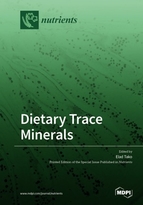Dietary Trace Minerals
A special issue of Nutrients (ISSN 2072-6643).
Deadline for manuscript submissions: closed (15 July 2019) | Viewed by 76490
Special Issue Editor
Interests: dietary micronutrients; Fe and Zn deficiencies; anemia; Zn status biomarkers; bioactive compounds; prebiotics; microbiome; nutrigenomics; intestinal functionality and development; polyphenols; in vivo models of human nutrition
Special Issues, Collections and Topics in MDPI journals
Special Issue Information
Dear Colleagues,
Minerals that are required in small amounts for human health are known as trace minerals or trace elements. These include chromium, copper, fluoride, iodine, iron, manganese, selenium, and zinc.
Minerals form only five percent of the typical human diet but are essential for normal health and function. Macrominerals are defined as minerals that are required by adults in amounts greater than 100 mg/day or make up less than one percent of total body weight. Trace elements (or trace minerals) are usually defined as minerals that are required in amounts between 1–100 mg/day by adults or make up less than 0.01 percent of total body weight. Ultra-trace minerals generally are defined as minerals that are required in amounts less than 1 microgram/day.
Recommended intakes for trace elements are expressed as Recommended Dietary Allowances (RDA) or Adequate Intake. The Upper Limit is the quantity of the nutrient considered to cause no adverse effects in healthy individuals. These parameters have been estimated for each trace mineral. Previous research demonstrated that: (1) Copper deficiency can be caused by an x-linked mutation of the transport protein mediating copper uptake from the intestine (Menkes disease). It can also be caused by malabsorption after gastrointestinal surgery (including gastric bypass for weight loss and gastric resection for malignancy or peptic ulcer disease), or by ingestion of high doses of zinc. Clinical manifestations include anemia, ataxia, and myeloneuropathy. (2) Iodine deficiency is characterized by goiter and hypothyroidism, which in turn has effects on growth, development, and cognitive function. (3) Selenium deficiency is unusual, but has been reported in parts of China where the local diet is devoid of selenium; the deficiency also occurs in individuals maintained on total parenteral nutrition without trace minerals. Clinical features of selenium deficiency are cardiomyopathy and skeletal muscle dysfunction. (4) Zinc deficiency causes growth retardation in children, hypogonadism, oligospermia, alopecia, dysgeusia (impaired taste), immune dysfunction, night blindness, impaired wound healing, and skin lesions. Infants with an inherited defect in zinc absorption develop a severe deficiency state known as acrodermatitis enteropathica.
The purpose of the current Special Issue is to further expand and add research knowledge on the vital role that dietary trace minerals hold in various physiological and metabolic pathways. In addition, to add more knowledge in regards to the relationship between dietary trace minerals bioavailability, the microbiome and bioactive compounds.
Prof. Dr. Elad Tako
Guest Editor
Manuscript Submission Information
Manuscripts should be submitted online at www.mdpi.com by registering and logging in to this website. Once you are registered, click here to go to the submission form. Manuscripts can be submitted until the deadline. All submissions that pass pre-check are peer-reviewed. Accepted papers will be published continuously in the journal (as soon as accepted) and will be listed together on the special issue website. Research articles, review articles as well as short communications are invited. For planned papers, a title and short abstract (about 100 words) can be sent to the Editorial Office for announcement on this website.
Submitted manuscripts should not have been published previously, nor be under consideration for publication elsewhere (except conference proceedings papers). All manuscripts are thoroughly refereed through a single-blind peer-review process. A guide for authors and other relevant information for submission of manuscripts is available on the Instructions for Authors page. Nutrients is an international peer-reviewed open access semimonthly journal published by MDPI.
Please visit the Instructions for Authors page before submitting a manuscript. The Article Processing Charge (APC) for publication in this open access journal is 2900 CHF (Swiss Francs). Submitted papers should be well formatted and use good English. Authors may use MDPI's English editing service prior to publication or during author revisions.
Keywords
- Dietary requirements of trace minerals
- Dietary Fe
- Dietary Zn
- Dietary Vit A
- Dietary Deficiency of trace minerals
- Physiological and metabolic pathways are affected by trace mineral deficiencies
- Trace minerals and dietary bioavailability
- Trace minerals and polyphenols
- Trace minerals bioavailability and prebiotics
- Trace minerals and microbiome







